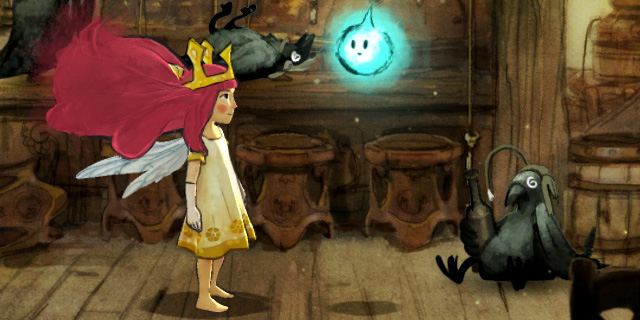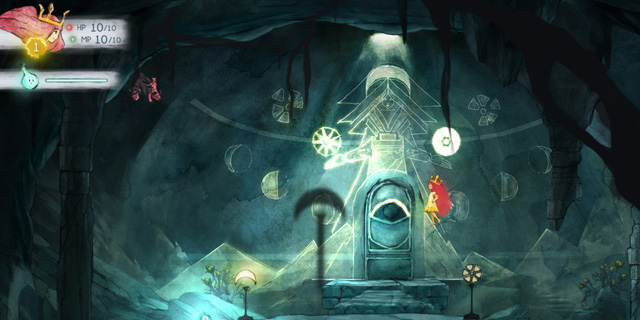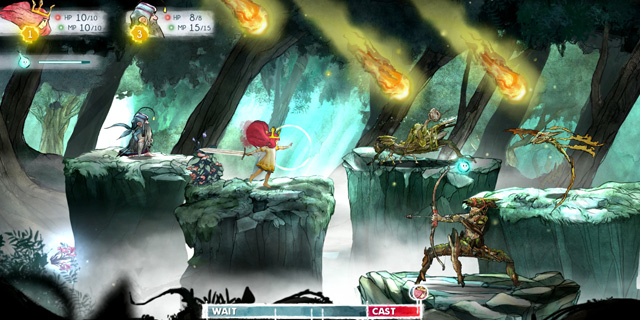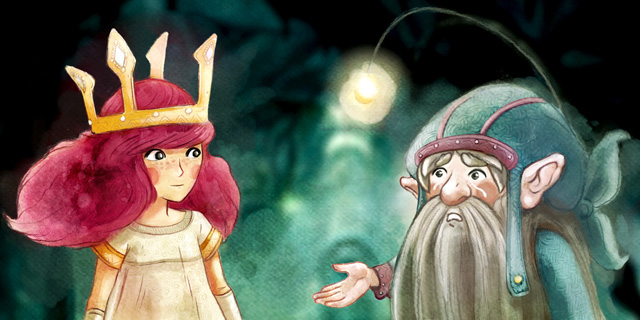
With the ability to turn production sketches directly into in-game assets, the UbiArt engine supplies some breathtakingly delicate visuals to Child of Light. The unique graphical design, combined with a haunting piano-dominated score, bring the story of Aurora’s journey through Lemuria to life in a way that will be remembered for a long time. While not flawless, this odd blend of turn-based RPG and flying platformer is certainly an experience worth investigating.
Enough can’t be said about the visuals here. With the programmers taking animation advice from members of Cirque du Soleil, Aurora flows naturally as she flits through the air on gossamer wings, her long red hair trailing behind her like Superman’s cape. Storybook environments, from overgrown forests to long-forgotten ruins, evoke a kingdom suffering under the rule of a tyrannical dark queen. The overall effect is dream-like, a watercolor painting in motion, and perfectly suits the framing narrative of a mother’s bedtime story to her daughter.
Where that narrative falls, however, is in the decision to present everything in a loose poetic structure. Sadly, the meter is uneven at best and many rhymes forced. Constantly switching between couplets and longer stanzas doesn’t help either. It’s a little jarring, and makes the fourth-wall breaking running joke of one character being completely incapable of making a rhyme feel wasted since the writers had enough trouble there as it was.

On the subject of characters, Aurora assembles quite the party before her adventure completes. There are about a half-dozen in all, each with their own specialties in typical RPG tradition. Only two are active in battle at any time. Thankfully, being able to swap them out on the fly mid-combat and full shared experience for the entire group makes managing them less of a chore than it would be in other games.
Combat itself uses an odd active turn-based system. Each character and enemy has an icon on a time track that moves toward a “casting” point. When an icon reaches that point, everything pauses while you select your option. Each action has a “casting time” that dictates how quickly the character’s icon passes through the final zone on the timeline, at which point the action actually happens. Anyone hit while “casting” is interrupted and loses their turn. This applies to enemies as well, so plan your actions carefully and you can avoid a lot of pain.
Helping you out in that respect is perhaps the most important member of Aurora’s team: her firefly companion. Positioning him over an enemy and shining his light will slow that enemy’s icon and possibly give you an opening you wouldn’t otherwise have had. Alternately, he can shine over one of your characters for some minor healing. Both of these are limited by his charge meter, which replenishes over time or by collecting “wishes” located in glowing bushes on the battlefield. Outside of combat he can be used to collect wishes, open chests, activate triggers, illuminate darkened passages or even stun enemies.

Stunned enemies can be passed safely, but fighting them is usually the better choice. If you initiate the attack from behind the enemy, you gain the advantage of surprise. Likewise, you can be ambushed if they initiate contact, so pay attention and use your firefly to keep them under control. Once defeated, enemies do not respawn until you have moved to a completely new area (or restarted after a break in play), leaving you free to explore.
Since Aurora gains the unrestricted ability to fly early on in her adventure, the platforming element of Child of Light is a bit different than usual. Mostly you have to navigate timed doors, traps, spiked walls/ceilings and enemies as you search out chests and switches.
Many chests will contain Oculi, gems that are the closest Child of Light comes to equipment. Oculi can be combined to create stronger or even different versions. This system is mostly intuitive, although trying to make diamonds can sometimes be frustrating when the game assumes you want to make a secondary gem instead.
Also intuitive is the skill system, with each character having three paths of development. Each level earns you one skill point, and until you reach the very ends of each branch each step costs one point so advancement is usually swift. By the end of my playthrough, all of my characters were right around level 50 and there were still plenty of options left to me.

Speaking of options, Child of Light offers one more unusual one: cooperative play. Envisioned as a way to let parents help out their kids, a second player can take direct control of the firefly using a second control pad. Not that using the right stick — or even the Wii U GamePad’s touch screen, if that’s your system of choice — is a chore for an veteran player, but it might be a bit much for a child of Aurora’s inexperience.
Aurora’s story is a classic coming-of-age adventure. Over the course of the journey, she will mature from a child longing to return to her father to an independent young queen, discarding selfish petulance for noble responsibility. The game itself doesn’t quite have the opportunity to mature in the same way, playing out in a mere 15 hours or so and ending somewhat abruptly. Still, at a gameplay rate of only about a dollar per hour, it holds up well against the scale of the more epic RPGs out there.
On normal difficulty, Child of Light probably won’t put up much of a challenge for anyone capable of playing without a second player’s aid, but plays out so quickly that it won’t have time to wear out its welcome. Awkward poetry aside, the presentation is the real star here, and in that Child of Light does not disappoint. Set aside a weekend to play this one for yourself, and re-experience the wonder and creativity that were once more common in the industry in a whole new light.
Pros: Captivating aesthetics, interesting mix of gameplay mechanics
Cons: Shaky poetic structure, narrative feels rushed



















